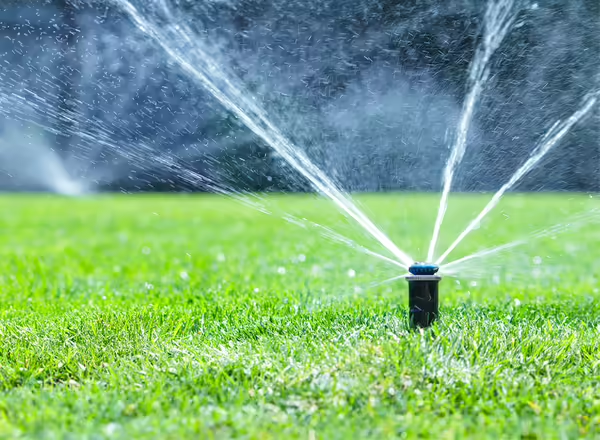
Watering Your Lawn
Cool-season lawn grasses, such as Kentucky bluegrass, perennial ryegrass, and fine fescues, vary in the amount of water needed for good growth. Factors such as the soil, weather, and management practices all have a role in the water needs of lawns. In general, about one to 1.5 inches of water per week is needed to maintain green color and active growth. Cool-season grasses naturally slow their growth and may go dormant in hot weather.

An important decision you need to make before summer is whether you will water lawns consistently throughout the season or let lawns go dormant as conditions turn warm and dry. Do not rotate back and forth. In other words, don't let the grass turn entirely brown, apply enough water to green it up, and then let the grass go dormant again. Breaking dormancy drains large amounts of food reserves from the plant, causing stress and making the grass plant more susceptible to disease.
It is perfectly acceptable to not irrigate your lawn. Most summers our cool-season lawns can withstand the hot, dry weather using dormancy as a defense mechanism. Autumn typically brings cooler temperatures and more rainfall and our lawns resume growth.
When and how often to irrigate
When is it time to water? The first few warm days of summer do not automatically mean it's time to water lawns. Allowing lawns to start to go under mild drought stress increases rooting. You can determine stress by watching for footprinting, or footprints remaining on the lawn after walking across it. Grasses tend to turn darker in color as they go under drought stress. Sampling the root zone soil could be another sign of stress. Push a long screwdriver into the soil. How far it goes often indicates how far water has penetrated into the soil. A soil moisture probe is a scientific tool to help measure soil moisture. Many irrigation systems can communicate with soil moisture probes in your lawn to help you save water and money.
In general, water infrequently. When you do irrigate make sure to water thoroughly so moisture gets down to the depth of the roots. Exceptions to this general rule would be for newly seeded lawns where the surface needs to stay moist or when patch disease is a problem. Otherwise, avoid frequent waterings, which promotes shallower root systems and weeds (i.e. crabgrass). Given a choice, water early in the day when lawns are normally wet from dew. Avoid midday watering. The water evaporates resulting in costing more with less water getting into the soil. Watering at night has the potential to promote the development of some turf diseases.
Monitor use and placement
Spread the water uniformly across the lawn. Sprinklers vary in distribution patterns and require spray overlap for uniform coverage. Placing coffee cans or similar straight-sided containers on the lawn can help measure water application rates. Avoid flooding areas or missing spots. Not having even coverage can create a patchy appearance. On heavy clay soils with lower water absorption rates and slopes, watch for excessive runoff; it may be necessary to apply the water in two applications to ensure it soaks in.
How much is too much?
Lawns are considered one of the largest irrigated crops in North America. But there are ways to conserve water when dealing with lawns. Mow higher, avoid excess nitrogen as warm weather approaches, limit traffic over the lawn, improve turf rooting, control thatch, ease soil compaction, and avoid pesticide use on drought-stressed lawns. Allow cool-season lawns to go dormant during the summer months and accept some plant species beside turfgrass. Using the adage, “If it’s green, it’s good!”
For irrigated lawns consider using a smart irrigation controller that only waters when your lawn needs it and provides adequate amounts of water.
Most lawns can survive drought, but extreme drought is a different situation.